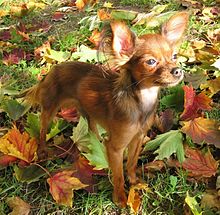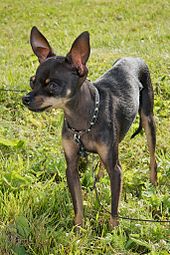- Russkiy Toy
-
Russkiy Toy A long haired Russkiy Toy Other names Russian Toy Terrier, Russian Terrier, Moscow Toy Terrier, Moscovian Miniature Terrier Country of origin Russia Traits Classification and standards FCI Group 9 (Provisional) Section 9 #352 standard UKC Companion Dog Group standard Notes The United Kennel Club (US) uses the Fédération Cynologique Internationale standard. Dog (Canis lupus familiaris) The Russkiy Toy (also commonly called the Russian Toy) is a very small breed of dog originally bred in isolation in Russia from the English Toy Terrier. There are two types, smooth haired/coated and long haired, which were known by a variety of different names until brought together under the same standard as the Russkiy Toy in 2000. The breed was nearly wiped out twice; first following in the 1920s with the rise of Communism due to the toy dog's traditional link to the aristocracy and secondly in the 1990s with the influx of foreign breeds following the fall of the Iron Curtain. The smooth haired type is the older of the two, with the long haired type first appearing in 1958.
Until the 1990s, the breed was almost unknown outside of Russia, and so relatively few details on associated health issues are known. The Russkiy Toy was bred as a rat fighter and as a watchdog originally, and can still exhibit the vocalisation expected from the latter. It is a friendly dog and can become very attached to a family unit. The breed has been recognised by a couple of international kennel clubs, and is registered in the Foundation Stock Service of the American Kennel Club.
Contents
Description
The Russkiy Toy is one of the smallest breeds in the world, measuring between 8 inches (20 cm) to 10 inches (25 cm) and weighing anywhere between 3 pounds (1.4 kg) and 6 pounds (2.7 kg).[1] It has a small distinctive head with large eyes and triangular ears. In countries where docking is prohibited, the tail is curved in the shape of a sickle.[1] There are two types in the breed, distinguished by their coats; one is long haired, and the other smooth coated.[2] The only differences between the two types is the long hair on the ears of the long haired type which is usually 3–5cm long and can be straight or with a slight wave.[1] Long haired dogs will grow a fringe on their ears by the age of three which should completely cover the outer edges and tips of their ears.[3]
The smooth haired type of the breed closely resembles the Pražský Krysařík breed of the Czech Republic.[3] The Pražský on average is a little shorter, but a little heavier than the Russkiy Toy.
Both of the varieties can be crossed and produce smooth and long haired puppies from the same litter. In addition, when two smooth coated dogs are bred together, they may occasionally bear a long haired offspring if the long hair blood is present in their pedigrees. However there have been no records of two long haired Russkiy Toys bred together and producing smooth coating offspring.[1]
The breed has five main colors, black and tan, blue and tan, brown and tan, sable or solid red of various shades.[2][4]
Health
A Russkiy Toy will often require veterinarian assistance in changing from its puppy teeth to its adult set. Without this surgery, two rows of teeth will form which can cause gum infections, bad breath and prevent the permanent adult set from coming forward.[5]
As with most breeds of dog, the Russkiy Toy can suffer from patellar luxation, which is where the knee cap slips out of place when the knee bends as the groove that normally holds it in place is too shallow. It is usually an inherited defect, which occurs during the development of the foetus and rarely by trauma.[5]
Russkiy Toys can suffer from bone fractures due to their small and sometimes delicate nature.[6] There have been reports of severe allergic reactions to certain types of flea medication and the rabies vaccine, causing epileptic seizures in some dogs.[7]
Temperament
Active and cheerful,[2] the Russkiy Toy was originally bred both as an anti-rat dog and a watch dog. The second quality is still active in the breed, and they can be very vocal. They can become quite attached to their family, regardless of the ages of the family members.[6]
History
The first evidence of English style terriers in Russia can be seen in the Museum of Zoology in Saint Petersburg. On display is an English style terrier dated 1716–1726 with a sign that reads "This dog is a short hair terrier named Lizetta. It personally belonged to the Russian Emperor Peter the Great.[8] Towards the start of the 20th century, the English Toy Terrier was one of the most popular toy dog breeds in Russia.[2] Between 1920 and 1950, their numbers were greatly diminished following the October Revolution as these types of dogs were linked to the aristocracy and frowned upon.[9] When the breeding was re-started almost all of the dogs used had no pedigrees or were even purebred.[2]
The original long haired Russkiy is considered to be a dog named Chikki who was born on 12 October 1958 from two smooth haired terriers. One its parents had no recorded pedigree, but had slightly longer hair than normal. Chikki was mated with a female named Irma, who had longer hair than normal and together they had three long haired puppies.[10]
The political isolation of the country at the time caused the creation of a whole new breed as breeders sought to stabilise the toy sized terriers at the time into a standard breed.[8] The first standard for the two varieties was written in 1966 and authorised by the Ministry of Agriculture.[9][10] After the fall of the Iron Curtain, a number of foreign small breed dogs were imported, and this caused the popularity of the Russkiy Toy to decline.[9] By the 1990s, the long haired type of Russkiy Toy had hit critical numbers, but luckily a resurgence occurred due to a new generation of dog breeders.[8] Until this time the breed was virtually unknown outside of its homeland.[9]
It was recognised by the Federation Cynologique Internationale in 2006[10] and the United Kennel Club in 2008.[2] It is also recognised by the American Rare Breed Association, North American Kennel Club and International All Breed Canine Association. It has recently been admitted into the Foundation Stock Service of the American Kennel Club which can be seen as a first step towards full AKC recognition.[11] In July 2009 the Russian Toy was approved to compete in AKC companion events from 1 January 2010 onwards.[12]
References
- ^ a b c d "Russian Toy". DogBreedInfo.com. http://www.dogbreedinfo.com/moscowtoyterrier.htm. Retrieved 2009-11-18.
- ^ a b c d e f "Russkiy Toy (Revised July 1, 2009)". United Kennel Club. http://www.ukcdogs.com/WebSite.nsf/Breeds/RusskiyToyRevisedJuly12009. Retrieved 2009-11-18.
- ^ a b "FCI-Standard N° 352 / 12.06.2006 / GB RUSSIAN TOY (Russkiy Toy)". American Rare Breed Association. http://www.arba.org/russian_toy.htm. Retrieved 2009-11-18.
- ^ "Russian Toy: Colors and Markings". American Kennel Club. http://www.akc.org/breeds/russian_toy/color_markings.cfm. Retrieved 2010-01-05.
- ^ a b "Russian Toy". Kennel Pomdies. http://www.pomdies.dk/Russian%20Toy%20in%20english.html. Retrieved 2009-11-17.
- ^ a b "Breed Info". Russian Toy Kennel: Malenkaya-Mafiya. http://www.toyterrieri.net/main.php?la=uk&port=1&page=8. Retrieved 2009-11-18.
- ^ "Russian Toy Dog Health Issues". Russian Toy Dog Club of America. http://www.russkiytoyclubofamerica.com/index.php?option=com_content&view=article&id=64&Itemid=76. Retrieved 2009-11-17.
- ^ a b c "History of the Russian Toy Dog". RussianToys.net. http://www.russiantoys.net/breedhistory.html. Retrieved 2009-11-18.
- ^ a b c d "Russian Toy Did You Know?". American Kennel Club. http://www.akc.org/breeds/russian_toy/did_you_know.cfm. Retrieved 2009-11-18.
- ^ a b c "History". Russkiy Toy Club of America. http://www.russkiytoyclubofamerica.com/index.php?option=com_content&view=article&id=53&Itemid=66. Retrieved 2009-11-18.
- ^ "Russkiy Toy Club of America". Russkiy Toy Club of America. http://www.russkiytoyclubofamerica.com/. Retrieved 2009-11-18.
- ^ "Russkiy Toy News". American Kennel Club. http://www.akc.org/breeds/russian_toy/news.cfm. Retrieved 2010-01-05.
External links
- Russian Toy Club of North America (in English)
- Russian Toy Dog Club of America
- Russkiy Toy Club of Finland (in Finnish)
Dogs originating in Russia Extant 
Extinct Categories:- Dog breeds originating in Russia
- Toy dogs
- Dog breeds
- Rare dog breeds
- Companion dogs
Wikimedia Foundation. 2010.




